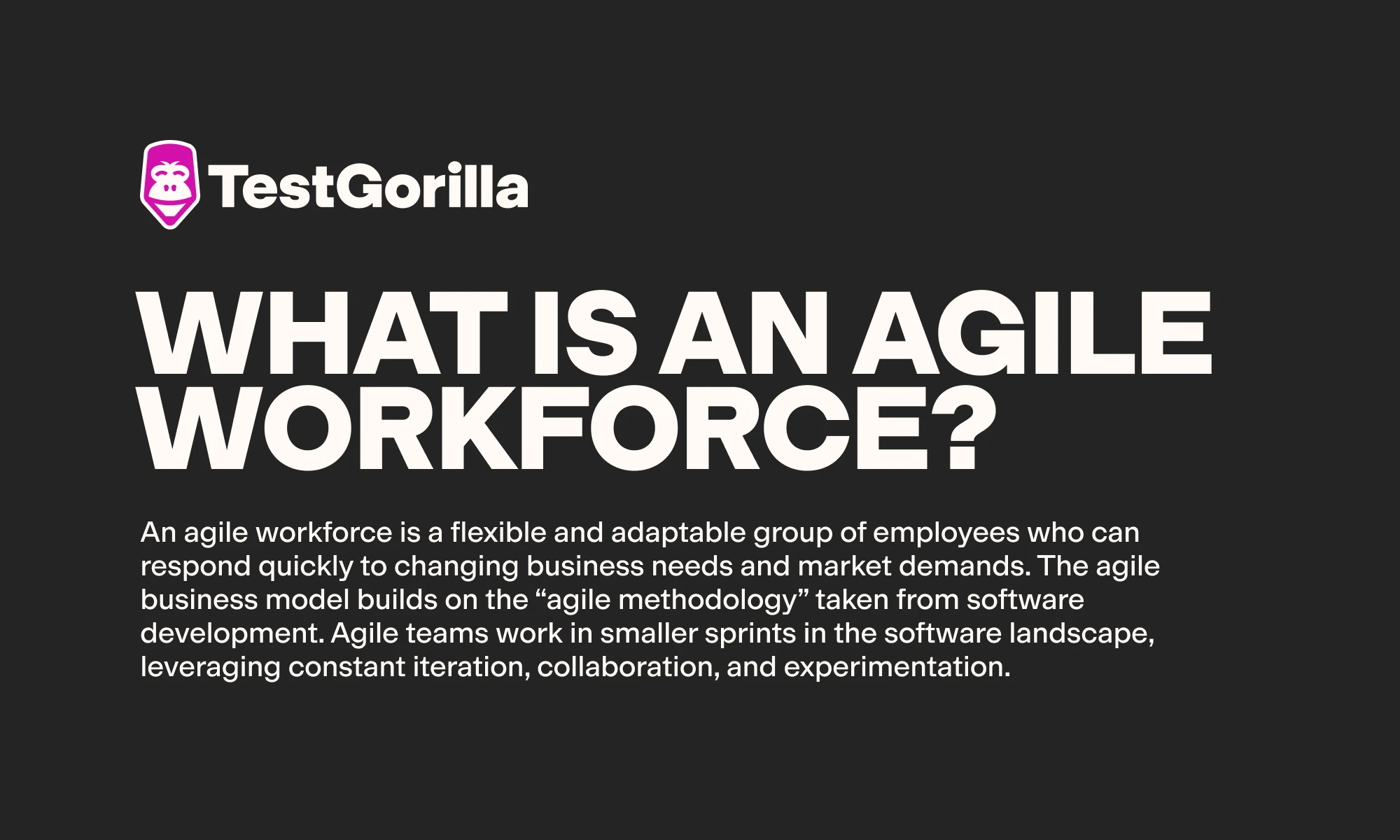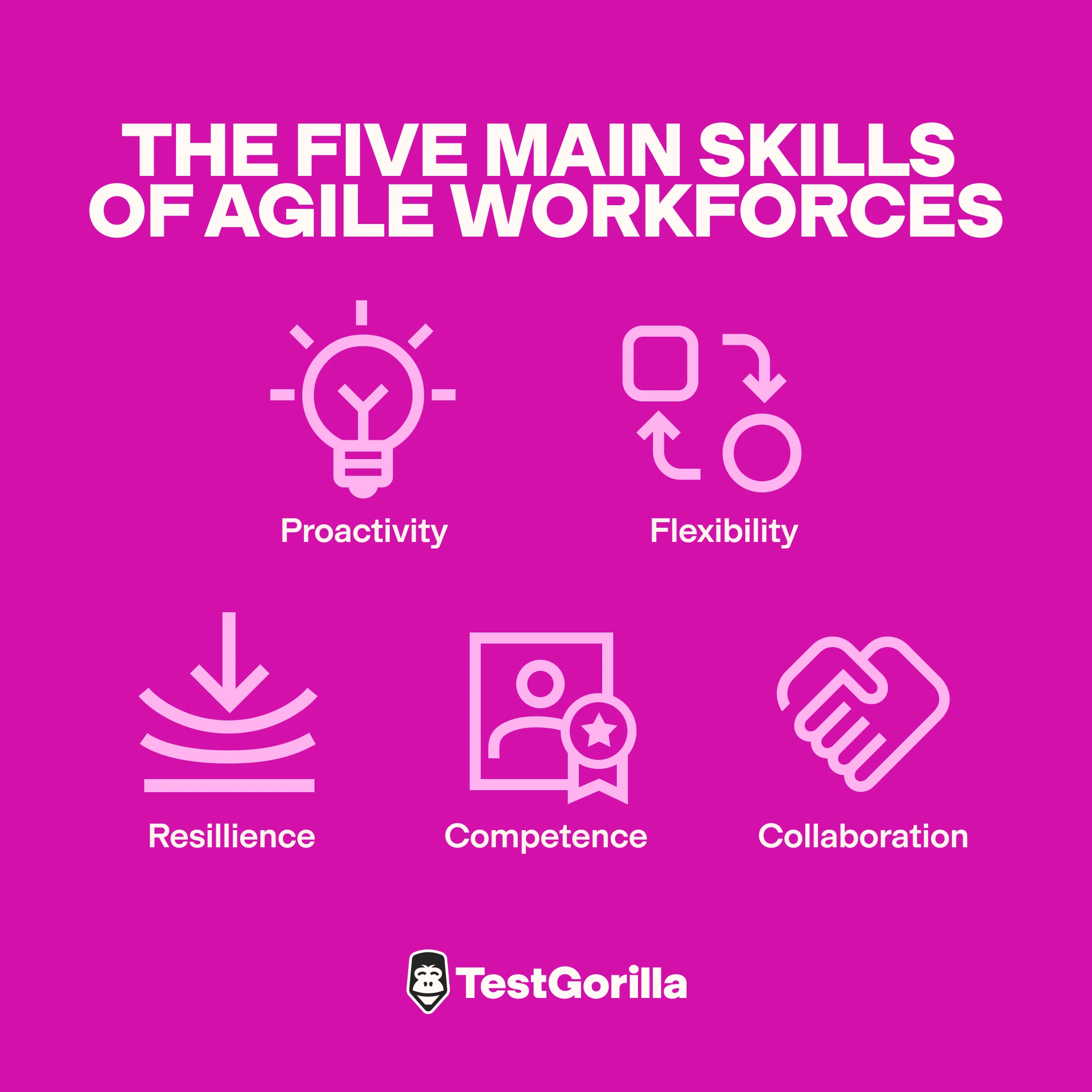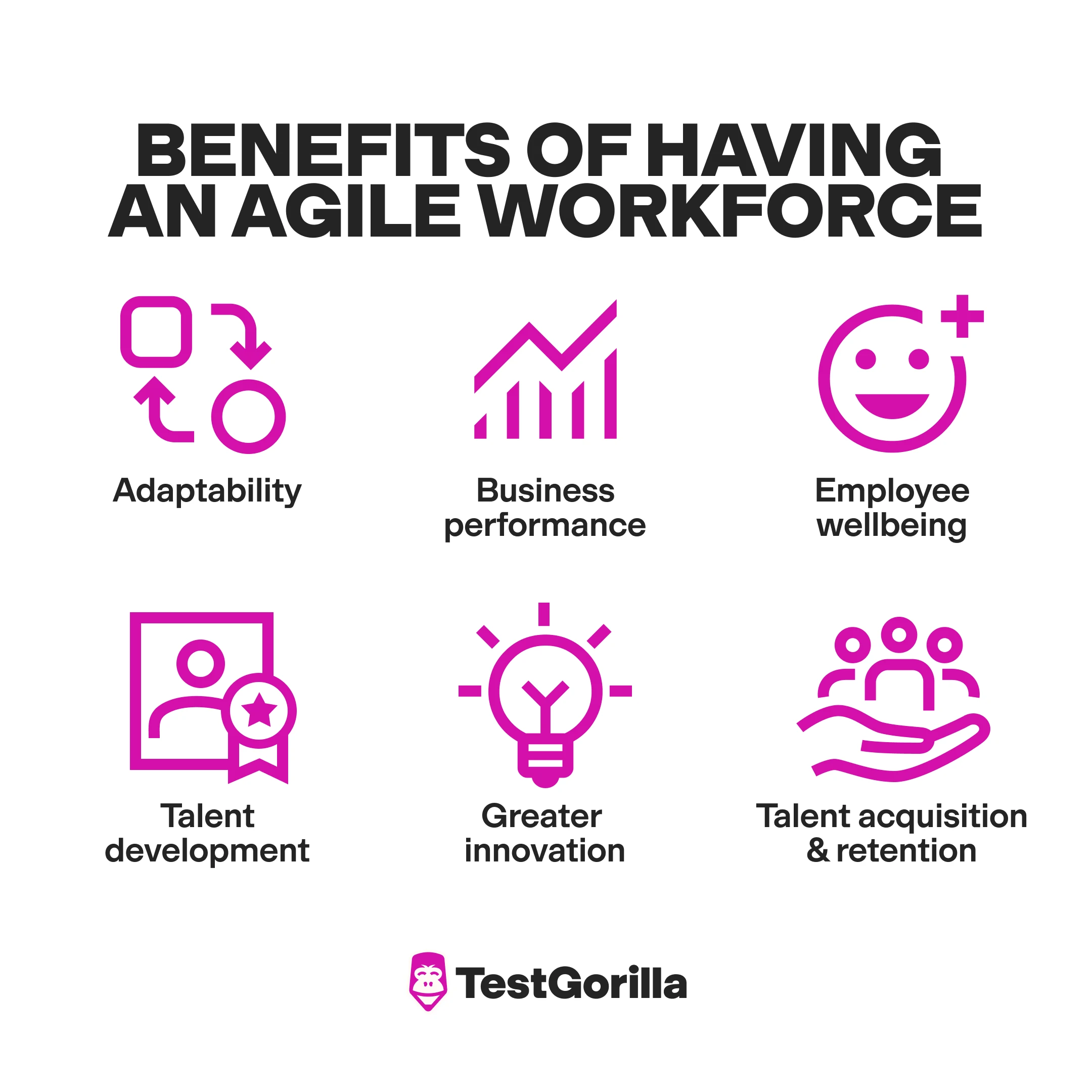An agile workforce: Why you need it and how to build one
Develop an agile workforce with skills-based hiring
Building an agile workforce has become a priority, with McKinsey showing that 93% of agile teams report better customer satisfaction and operational performance.
Diminishing stability in the business world, caused by changing customer preferences, technological advances, and workplace trends like hybrid and remote work, drives demand for resilient, adaptable teams.
Workforce agility ensures organizations can navigate rapid market changes and remain competitive.
But how can employers harness the agility and skills of their human capital and reap the benefits of an agile workforce? This guide shares everything you need to know.
Table of contents
- What is an agile workforce?
- Why is an agile workforce important? The business benefits
- What skills do agile workforces typically possess?
- The agile workforce planning approach
- 5 strategies for building and developing an agile workforce
- Support workforce agility with skills-based hiring
- Agile workforce FAQs
What is an agile workforce?
An agile workforce is a flexible and adaptable group of employees who can respond quickly to changing business needs and market demands. The agile business model builds on the “agile methodology” taken from software development. Agile teams work in smaller sprints in the software landscape, leveraging constant iteration, collaboration, and experimentation.
However, agility isn’t just beneficial for software development. Business leaders in any industry can adopt a similar agile methodology for their companies.
Building an agile workplace involves nurturing team characteristics like:
Resilience: The capacity to withstand and recover quickly from change
Flexibility: Openness to diverse working styles and processes
Collaboration: Cross-functional teamwork and talent sharing between staff
Proactivity: The ability to anticipate future needs and creatively resolve problems
Competence: Confidence and skill in completing essential tasks
Putting together a workforce with agile ways of working isn’t simply about hiring the right people. It extends far beyond that, demanding a strategic shift in HR practices to embrace versatility, resilience, and continuous learning.
Agile workforce examples
So, what does an agile workforce look like in the real world?
An agile workplace focuses on achieving incremental goals, achieving flexibility, and prioritizing constant development. Although agility can present itself differently depending on the environment, here are two great agile workforce examples:
Google boasts one of the best examples of an agile workforce. The tech giant’s workforce is characterized by a culture of problem-solving and continuous improvement.
One form of agile workforce management Google pushes for involves the encouragement of experimentation and risk-taking. Employees must spend 20% of their time on new ideas and projects outside their day-to-day responsibilities.
This program cultivates personal initiative, rewards creativity, and has contributed to new product innovations like AdSense and Google News.
TestGorilla
We’ve created an agile workforce through deliberate HR practices that promote adaptability.
For example, our digital transformation into a remote work-centered company helps us attract highly engaged workers internationally.
Our system includes investing in positive work environments and technology stipends to empower individuals to contribute in the best way they can. Also, instead of focusing on misleading resume experiences, we hire based on unbiased assessments of the skills and character traits associated with a proactive, nimble, and effective workforce.
Hire and develop agile teams with TestGorilla
Skills tests help you identify agile, resilient employees with the right mindset to embrace agility and facilitate future development plans.
Why is an agile workforce important? The business benefits
Technological, cultural, and competitive pressures have led to a business environment that requires fast responses to unforeseen challenges. An agile workforce is the key to a resilient business, making you ready for the future of work.
Investing in agile workforce solutions drives greater:
Adaptability: Workforce agility breeds adaptability. Agile teams can quickly pivot to embrace new technology, market dynamics, and customer preferences. This cultivates constant evolution and helps to minimize disruptions.
Business Performance: McKinsey showed that agile workforce transformations improve customer satisfaction, employee engagement, and operational performance. Together, these benefits contribute to a financial outcome 20%–30% greater than before an agile workforce transformation.
Employee wellbeing: 70% of companies using agile development methods report greater project management visibility and transparency between teams. Additionally, 60% of the companies in the same study benefited from better team morale.
Talent development: Agile team members often have a “growth mindset.” They’re committed to gathering feedback, learning from their mistakes, and building new skills. This creates a company culture of constant optimization and improvement.
Greater innovation: Agile workplaces empower employees to share ideas and take risks. Cross-functional, collaborative, and constantly evolving teams can often innovate faster, driving business growth.
Talent acquisition and retention: 80% of HR managers struggle with talent shortages. However, agile workforces navigate this issue by enabling better internal mobility within their companies. Up to 63% of employees are open to exploring new career opportunities.
Whether it’s higher profits, better employee engagement, or reduced costs, an agile workforce offers numerous improved metrics to companies willing to invest appropriately in their people.
What skills do agile workforces typically possess?
Skills-based hiring and skill development strategies are two core elements of building an agile workforce. Agile teams need specific competencies to adapt quickly and effectively to the changing status quo.
Although various skills can contribute to workplace agility, five key soft skills stand out from among the best agile teams:
Agile workforce skills | How these skills appear in the workplace |
Proactivity: Taking initiative, anticipating future needs and challenges, and creatively resolving problems. | Proactive employees consistently analyze and anticipate future challenges and opportunities. They pay attention to trends and intuitively adapt their processes. |
Flexibility: Ability to adapt and adjust according to changing circumstances and demands. | Flexible employees are open-minded and willing to consider and adopt alternative processes and approaches. They feel comfortable with experimentation. |
Resilience: Withstanding and recovering quickly from new changes and circumstances. | Resilient employees show strength, tenacity, and persistence in the face of new challenges. They recover quickly from disruptions and changes. |
Competence: Perpetually incorporating new information, building confidence, and developing new skills. | Competent employees commit to life-long learning practices. They invest in improving their soft and hard skills and exploit development opportunities. |
Collaboration: The ability to work effectively as part of a cross-functional or interdepartmental team. | Collaborative employees work in cross-functional teams, seek diverse perspectives, and prioritize feedback. |
The agile workforce planning approach
Enabling an agile workforce transformation requires companies to rethink their hiring, workforce planning, and skill development approach.
Agile workforce planning transforms rigid, linear methods of setting workforce plans into an iterative process that adapts to changing industry dynamics.
One well-established framework to consider comes courtesy of AIHR.
The approach lays out six individual steps:
Baseline: First, identify the company’s overarching workforce planning strategy to determine which stakeholders should be involved.
Supply: Next, HR should form a clear view of the current state of the workforce and determine how planned hiring efforts, natural turnover, and internal reorganizations impact it.
Demand: Leaders must then translate company targets into demand for skills and talent. This step considers where, when, and what type of people are needed to hit goals and adapt to industry trends.
Gap analysis: This step contrasts the demand for employees with the talent supply to understand missing skills or positions.
Action plan: With a firm grasp of talent management, HR can engage with stakeholders to determine how to restructure the workforce, address gaps, and improve flexibility.
Delivery: Finally, HR can implement the workforce changes necessary to balance supply, demand, and company constraints.
What makes this workforce planning approach agile is that it’s iterative. HR should continuously monitor the company’s experience against their assumptions and make real-time changes as imbalances arise.
5 strategies for building and developing an agile workforce
Companies that want to build an agile workforce need to increase the adaptability of their people, processes, and tools. Although it’s tempting to think that hiring the right people is enough to create this outcome, the entire employee experience is at play.
Use the following holistic HR strategies to develop agility within employees and leaders at all levels.
Expert tips to increase workforce agility: A summary
If you’re ready to start increasing your workforce agility but are short on time, here are five top strategies at a glance:
Strategies to build an agile workforce | What this means in practice |
Hire for the right mindset | Screen for a growth mindset to find agile workers from the start |
Empower employees | Create an environment that rewards intuition, proactivity, and flexibility. |
Develop and retain expertise | Develop agility intentionally with ongoing job training and development opportunities |
Learn to share talent | Place talent where you need it most to get the best outcomes. |
Become a skills-based organization | Emphasize skills that contribute to agile workforces rather than focusing on impressive resumes |
1. Hire for the right mindset
Agile employees take on challenges, adapt to unplanned scenarios, and stay open to information. These characteristics are all common in employees with a growth mindset.
To identify employees with the right mindset for workforce agility, start by including multipotentialites in your talent pool.
Multipotentialites have many talents and immense cognitive flexibility. They possess the superpower to acquire new skills rapidly and commit to regular learning and development, making them ideal for complex roles and dynamic workplaces.
HR Teams and leaders can use skills tests to identify top talent multipotentialities. For instance, you can use TestGorilla’s skill assessments to combine up to five skill tests from different categories, ranging from cognitive ability to situational judgment.
You can also integrate these skill tests with personality tests, such as the Big 5 OCEAN test, which examines factors like “emotional stability” – a key factor in agility and resilience.
Use TestGorilla to optimize your talent assessments.
Getting started is quick, simple, and completely free! Just sign up and start browsing through tests to evaluate crucial skills for your agile workforce.
2. Empower employees
Agile workforces need to experiment, take risks, and explore new ideas. Employees can’t innovate if they’re restricted to following specific processes. Companies need to foster a culture of trust and empower workers to feel psychologically safe in the workplace.
Allow team members to adapt their processes based on their skills and strengths. Encourage experimentation and creativity by rewarding staff members who think outside the box and take risks.
Consider embracing flexible HR policies that enable teams to adapt their schedules based on their needs. Some team members may perform better in a remote or hybrid environment and achieve more in a four-day workweek.
3. Develop and retain expertise
Today, when skills become obsolete quickly and technologies constantly change, it’s not enough to rest on experience and education.
Your workforce needs ongoing training and development to stay agile.
Look for opportunities to upskill and reskill your employee base and give them the tools to succeed. Use internal talent assessments to identify skill gaps and develop personalized training programs.
Once you’ve nurtured the right skills in your workplace, make the most of them. Introduce employee retention strategies, such as offering career advancement opportunities to hold onto expertise.
4. Learn to share talent
Agile organizations realize that talented people are what drive progress forward. You should place workers in whatever position unlocks the most positive impact.
Although you could hire an employee for one role, their changing business priorities and skill set over time could dictate that they are a better fit in another department.
Rigid workforces can’t stand this idea – leaders hoard talent or worry about managing a rising star.
Agile workforces, on the other hand, encourage flexibility and movement through things like:
Internal mobility programs
Job-shadowing
Promotions and expanded responsibilities
Internal talent marketplaces
Sharing talent like this is a critical strategy to build an agile workforce that shifts to changing company needs.
5. Become a skills-based organization
Skills-based organizations are more adaptable by design.
Rather than focusing on traditional “career tracks,” they focus on hiring and training skilled workers who can solve the company’s problems.
Becoming skills-first helps organizations build agile workforces by finding talent that can adapt to versatile job definitions and evolving responsibilities.
Use skills-based testing to identify your candidate’s core skills before hiring and determine where additional training and support might be necessary. A good thing to test when searching for agile candidates is their critical thinking skills.
TestGorilla’s critical thinking test evaluates how employees identify issues, process information, and make sound judgments in an agile environment.
Support workforce agility with skills-based hiring
Building an agile workforce makes sense because every company needs a team that can rapidly adjust to today’s rapidly shifting technological advances and customer needs. Creating an agile workforce, however, requires a comprehensive strategy. You need to adopt an agile workplace planning strategy, adjust your workplace processes, and commit to constant employee development. Hiring is not the only ingredient in this recipe, but it prepares your agile workplace for success. So, conduct a skill assessment the next time you wonder whether a candidate is agile enough to fit your needs.
At TestGorilla, we offer a library of more than 400 tests to help you evaluate candidates based on personality traits, skills, and mindset.
Sign up for our Free forever plan for unlimited access to critical manager soft skill tests related to problem-solving and communication.
lternatively, take our product tour or request a demo for insights into our advanced selection of IT manager tests and assessments.
Agile workforce FAQs
Do you still have lingering questions about agile workforces? Find the answers below:
What does “agile workforce” mean?
An “agile workforce” refers to a company with employees who can quickly adjust to rapidly changing market conditions and an uncertain work environment (like the one we face in the 21st century). These workers can acquire knowledge, technical know-how, and skills, and are also highly resilient, proactively adopting flexible behaviors and mindsets when their job requirements change.
How do you build an agile workforce?
Hire for the right mindset
Empower employees with a culture of trust and flexibility
Develop and retain expertise and skills
Adopt flexible working policies
Become a skills-based organization
Scroll up to the “5 strategies for building and developing an agile workforce” section to learn more.
Why do companies need an agile workforce?
An agile workforce enables companies to thrive in a rapidly changing environment. Thanks to a continued focus on growth, development, and collaboration, agile teams are often more productive and resilient. They can adapt to changing customer preferences, embrace new technologies, and remain productive in difficult situations.
Related posts
You've scrolled this far
Why not try TestGorilla for free, and see what happens when you put skills first.
Latest posts
The best advice on pre-employment testing, in your inbox.
No spam. Unsubscribe at any time.

Hire the best. No bias. No stress.
Our screening tests identify the best candidates and make your hiring decisions faster, easier, and bias-free.
Free resources
This checklist covers key features you should look for when choosing a skills testing platform
This resource will help you develop an onboarding checklist for new hires.
How to assess your candidates' attention to detail.
Learn how to get human resources certified through HRCI or SHRM.
Learn how you can improve the level of talent at your company.
Learn how CapitalT reduced hiring bias with online skills assessments.
Learn how to make the resume process more efficient and more effective.
Improve your hiring strategy with these 7 critical recruitment metrics.
Learn how Sukhi decreased time spent reviewing resumes by 83%!
Hire more efficiently with these hacks that 99% of recruiters aren't using.
Make a business case for diversity and inclusion initiatives with this data.
























